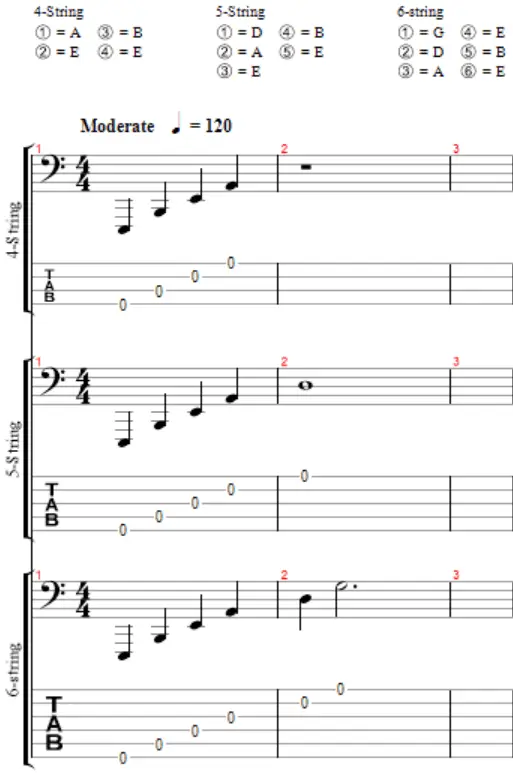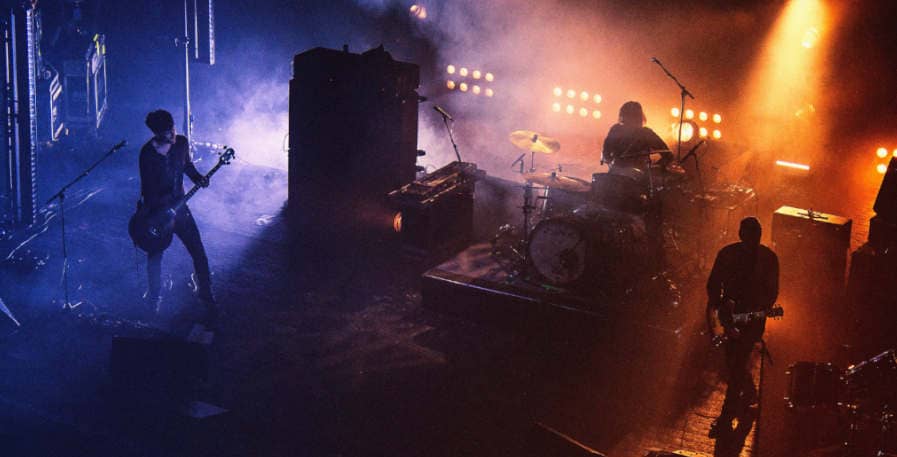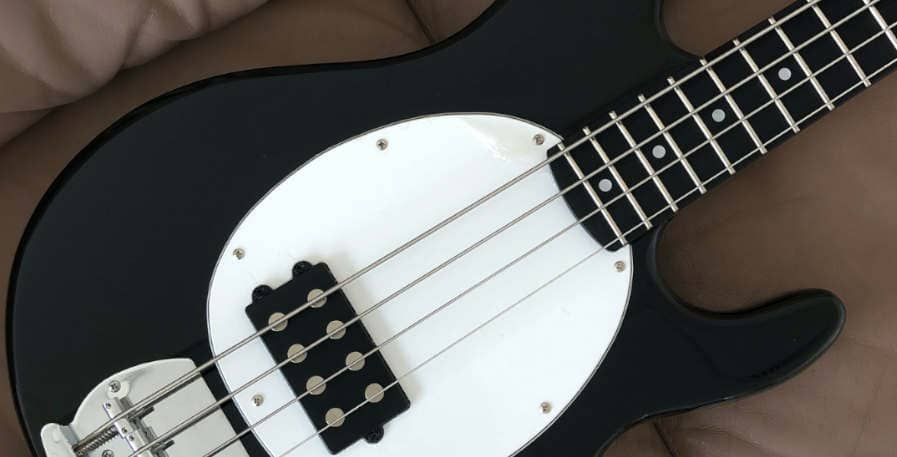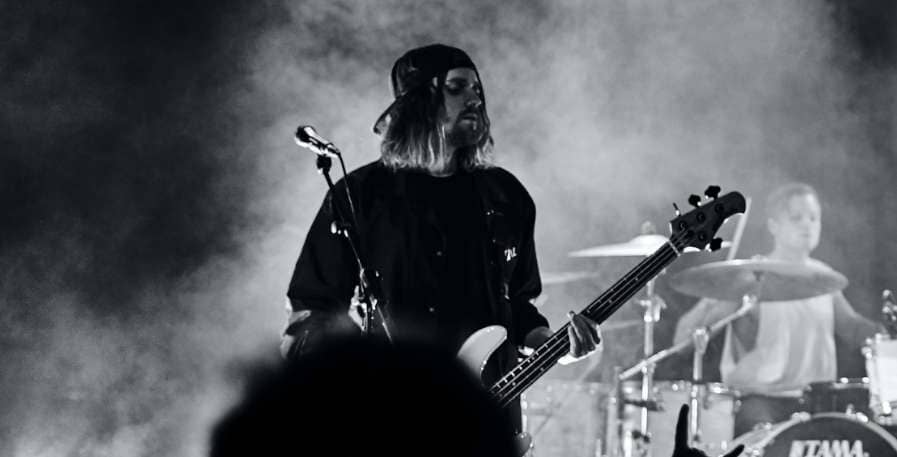Drop E is among the lowest bass tunings that you will find out there.
The tuning has seen slightly more use in sub-genres of metal in the last decade. However, due to its extremely deep range, bands that tune to Drop E are few and far between.
When done right though, the tuning can sound incredibly punchy and groovy at the same time. That`s why I`ve written this guide to showcase what tuning to drop E entails, and how to go about it if you decide to give this tuning a try.
You`ll be shown how to tune a 4, 5, or 6-string bass to Drop E, and there is a tuner below that you are free to use. I`ll also go over some bands that use the tuning, the pros and cons of it, what strings to choose, and how to set your bass up for Drop E.
What does Drop E tuning mean?
Drop E tuning means that the heaviest string of the bass is an E that has been tuned down a whole step from its standard tuning. In drop E the lowest string is thus an octave deeper than in E standard, and the strings are tuned E-B-E-A on 4-string basses, and E-B-E-A-D on 5-string basses.
“Dropping” a string means the same as tuning it down. The strings of a bass guitar are always tuned a perfect fourth apart in standard tunings. In drop tuning, on the other hand, the deepest and second deepest strings are tuned a perfect fifth apart.
The standard tuning for 4 and 5-string basses are E standard and B standard respectively. Since dropping means tuning down, we need to tune all the way down to E0 an octave below E standard to reach Drop E.

This makes the tuning extremely deep. Therefore, your bass has to be set up correctly, have thick enough strings, and that you will need an amplifier can handle frequencies this low.
Because of this, Drop E has a relatively high barrier of entry, as not all bass gear will be able to handle it. To solve this, some bands elect to record the bass in a higher tuning, and pitch shift it down.
“We are using something called a Whammy Drop Tune Pedal, which has a negative 5 pitch-shift on this, which brings it down from A, to E. That`s why it sounds a little strange.”
Andrew Baena of Carcosa on recording and shift-pitching bass – “Absent” playthrough on Youtube

Why use Drop E tuning?
While tuning a bass to drop E takes some effort, the tuning also has some major upsides. Here are the key reasons bassists and bands choose drop E over other tunings:
- Extremely heavy sound – Two of the most common metal tunings are Drop D and Drop C. These tunings are often regarded as low enough and provide enough deep range to attain a heavy sound. Drop E however, is 4-whole steps deeper than Drop C. Thus, the tuning can be used to sound significantly deeper and heavier than what common alternate bass tunings allow you to.
- Modern tone – Tuning as low as drop E is a modern trend. No one tuned even close to this low in the last Millenium, and most bands that utilize this tuning have mostly done so in the 2010s and 2020s. Thus, while the tuning is not widely used, it will still feel fresh and modern to listeners. It will either feel new due to them never having heard anything like it before, or them associating the sound of it with other modern bands.
- Standing out – Drop D and C are great for making metal sound like metal and standing out from other genres. Drop E on the other hand is great for standing out within the metal genre. As few bands tune this low, there will be an inherent uniqueness to the music your write in this tuning. In particular, no one will ever forget the first time they hear a good breakdown in Drop E.
Drop E bass tuner
In Drop E, it can be hard to discern the pitch of the open E string. This is because frequencies below 20hz are what we call infrasound. Generally, most people cannot tell the difference in pitches within this range.
E0 is the lowest note above the infrasound range with a frequency of 20.6 Hz. In one sense, this makes Drop E the lowest possible bass tuning, though bands have tuned lower and made it work despite this.
Thus, if you struggle to tune the low E string to E0, this is completely normal. What I find helpful is “feeling” the note, rather than listening to it. Despite the pitch being hard to hear, it will still be harmonious with the tuner and thus feel tensionless and resolved.
With that said, here is a tuner that you can use to tune 4, 5, and 6-string basses to Drop E:
E0:
B0:
E1:
A1:
D2 (For 5 and 6-string basses):
G2 (For 6-string basses):

Bands that play in Drop E
Drop E has mainly been utilized in heavier sub-genres of metal. It has been used by several Djent bands, as well as in metalcore, deathcore, as well as various forms of progressive metal.
Here are some bands and bassists that have released music in Drop E, and what songs by them are played in this tuning:
| Band | Bassist | Notable songs in Drop E: |
| Animals As Leaders | None. Bass tracks are recorded by guitarist Javier Reyes since 2015. | The Woven Web |
| Hacktivist | Josh Gurner | Cold Shoulder |
| Currents | Dee Cronkite | Silence |
| Frostbitt | Kevin Renè Solheim | Frozen |
| Enterprise Earth | Dakota Johnson* (*Live member since 2021) | Empty Sockets |
| Born Of Osiris | Nick Rossi (Since 2018) | Silence The Echo |
| To The Grave | Matt Clarke | Miserable Summer |
| Invent Animate | Caleb Sherraden | The Sun Sleeps |
| Humanity’s Last Breath | Buster Odeholm | Ocean Drinker |
Drop E bass strings
If you are going to play in drop E without pitch shifting your bass, you will need incredibly thick string gauges.
The low E string is going to make or break your sound. I would not recommend going any lighter than a .170 for the E, and preferably significantly thicker. Chances are that you are looking for a heavy and resonant tone if you are tuning this low, and a string that is on the thicker side will help you achieve this. The ideal gauge for the E will thus be in the .200 to .210 range for most bass players.
Most string manufacturers don`t make strings this heavy. Kalium, previously known as Circle K, offers some strings in .200+ gauges, though most of them are intended for extra long-scale basses. Another option is New Tone Strings, who allow you to order custom strings.
The rest of the strings are tuned from B0 and up at perfect 4th intervals. This means that any standard set intended for 5-string basses will fit them perfectly in Drop E.
You will not need the 1 or 2 lightest strings of the 5-string set, depending on whether you have a 4 or 5-string bass. Bassists with a 6-string can make full use of the set for their remaining 5-strings.
A medium 5-string set of roundwound strings will do the trick. If you already own a 5-string or 6-string, you can also use its current strings by moving them a slot higher.
Thus, for a resonant, yet playable set use string gauges of ~.200-.135-.105-.075 for a 4-string. Add an additional .060 string for 5-strings, and a .045 for 6-string basses. Deviating somewhat from these gauges is completely fine, but this is generally the range you want to stay within.

Setting a bass up for drop E
After you get your hands on the right strings, it`s time to set up your bass for drop E.
This is something you can do at home, or you can pay a luthier to do it for you. Luthiers charge on average $63.18 for a bass setup excluding strings.
If you’re gonna set up your bass for drop E on your own, here`s what your gonna need to do:
Adjust neck tension
When the tension of a bass` neck is set correctly, it should bow ever so slightly and the frets shouldn’t buzz. When switching to significantly thicker strings, the neck is expected to bow more than it should.
This can however be solved with a truss rod adjustment. This is a rod located inside the neck of your bass that counters the tension of the strings and prevents the neck from contorting.
There is a small compartment where the neck meets the body, or where the neck meets the headstock. On most basses, it has a lid that has to be removed with a screwdriver. Inside it is a screw that can be turned with an alan wrench to adjust the truss rod.
Turn it clockwise to tighten the truss rod and straighten the neck. Only turn the wrench 1/8th of a full turn at a time.
Tune your bass back to Deop E and inspect the neck after each time to see if adjusting it more is necessary. Repeat the process till the neck has a slight bow, and till you don`t experience any fret buzz when plugging it in.
Adjust the Action
Action refers to the space between the strings and the frets. You generally want low action to make the strings easier to play, especially in a tuning as low as Drop E.
Adjusting the truss rod will help lower the action, but you also need to adjust the bridge of the bass.
The strings on your bass are situated in small saddles on the bridge which can be lowered. This is done with the help of a small alan wrench.
Lower the saddles of each string until they all feel playable and don`t produce any fret buzz. How low you want to go is a matter of preference, though many bassists prefer setting it as low as possible.
File the nut
The nut of a bass has to fit the strings in order for them to be playable. When switching to drastically thicker strings, you will need to file the nut in order to fit the new strings.
Use files to make the cuts in the nut wider and deeper. Do so in small increments and test out how well the strings fit in the nut slots often.
Make sure you gather all excess filings. It`s best to avoid making the cuts too deep, though if it happens you can glue the extra filings back onto it. Repeat the process until all the strings fit comfortably in the nut slots. If you don`t have a file, here is an affordable and easy-to-use set of needle files that will do the trick.
Conclusion
While Drop E isn’t for everyone, it’s the perfect tuning for some.
As long as you have thick enough strings, a proper setup, and an amplifier that can handle it, this tuning can be absolutely mind-melting.
Bands like Animals as Leaders and Currents have shown that Drop E can be used to play both hard-hitting riffs and breakdowns. They have also shown that the tuning can work well as a heavy backdrop to beautiful guitar melodies.
Thus, this is a fitting tuning for any bassist looking for a modern djent, metalcore, or deathcore sound. The tuning hits a unique sweet spot where it sounds fitting for these genres, but is also uncommon enough that it will help you stand out at the same time.
After you tune down your bass to drop E, it’s time to write some hard-hitting bass grooves. If you need some help on where to start, check out my guide on these essential metal bass scales.

